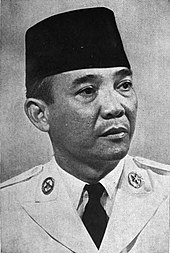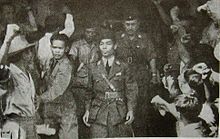Panglima (archaic form: penglima, Jawi: ڤڠليم) a military title used in Indonesia and Malaysia, and historically in the Philippines. It means 'a commander of a body of troops' deriving from lima, a long-obsolete word for 'hand'. In the past it is used to call some prominent military leaders in Malay world. The prominent Malacca and succeeding Johor Sultanates place the position of a penglima as below that of a menteri. Walter William Skeat writes that Semang tribes north of Malay Peninsula are often headed by shamans (belian) also titled pelima.
In modern times it is reserved for the chiefs of the armed forces of Indonesia and Malaysia and some other posts.
Use in Indonesia
Panglima Tertinggi Angkatan Bersenjata Republik Indonesia

As stipulated in article 10 of Indonesian Constitution, the President of Indonesia is the Supreme Commander of Indonesian Armed Forces (Panglima Tertinggi Angkatan Bersenjata Republik Indonesia). Essentially it is parallel to the title 'Commander-in-Chief' in other countries, e.g. the United States.
During the Old Order era, this title is included into many honorific titles that were often mentioned each time Sukarno's name was written or read in speeches, edicts, or news.
Panglima TNI
In Indonesian National Armed Forces, the highest position overseeing the three branches—Army, Navy, and Air Force—is known as the Panglima Tentara National Indonesia ('Commander of the Indonesian National Armed Forces'). Before the National Police separated from the Armed Forces in 2000, the organization comprised four branches and was known as Angkatan Bersenjata Republik Indonesia (ABRI). This included the TNI and the Police. The commander of the Armed Forces at that time was referred to as the Panglima ABRI, commonly abbreviated as Pangab.
According to the revised Constitution, the Panglima is appointed by the president, but the appointment must first be confirmed by the House of Representatives. Prior to the 2002 constitutional amendment, the president held the prerogative to appoint or dismiss the Panglima at their discretion.
Panglima Besar

The honorific title Panglima Besar, meaning 'Grand Commander' was informally bestowed upon Sudirman, the first Commander of the Armed Forces and a key leader of guerilla war during Indonesian National Revolution (1945–1949).
Other military uses

The title Panglima is widely used across various branches and formations within the Indonesian Armed Forces, signifying its importance in military leadership roles:
Army
- The commander of Kostrad, a strategic reserve command within the Army, is referred to as the Panglima Kostrad. Notably, the first Panglima Kostrad was Suharto, who later became the President of Indonesia (1968–1998), followed by Umar Wirahadikusumah, who went on to serve as the Vice President of Indonesia (1983–1988).
- The commanders of the 15 Regional Military Commands (Komando Daerah Militer or Kodam) are known as Panglima Daerah Militer (Pangdam).
Navy
- The commanders of the three Fleet Commands (Komando Armada I/II/III) hold the title Panglima Armada I/II/III (Pangarmada I/II/III).
- The highest position in the Military Sea-lift Command (Komando Lintas Laut Militer or Kolinlamil) is held by the Panglima Kolinlamil.
Air Force
- The commanders of the three Air Force Operations Commands (Komando Operasi Udara Nasional I/II/III or Koopsau I/II/III) are titled Panglima Koopsau I/II/III.
Past usage
Upon the formation of the Fourth Working Cabinet on 19 November 1963, the title Panglima was used for the commanders of each branch of the Indonesian Armed Forces. These commanders were also members of the Cabinet and were therefore given the title Menteri (Minister), appointed directly by the President. Their titles were as follows:
- Minister/Commander of the Army (Menteri/Panglima Angkatan Darat, abbreviated Menpangad)
- Minister/Commander of the Navy (Menteri/Panglima Angkatan Laut, abbreviated Menpangal)
- Minister/Commander of the Air Force (Menteri/Panglima Angkatan Udara, abbreviated Menpangau)
- Minister/Commander of the Police (Menteri/Panglima Angkatan Kepolisian, abbreviated Menpangak)
This practice was discontinued during the New Order era, when the title Panglima was replaced with Kepala Staf (Chief of Staff) for the commanders of the three military branches and Kepala Kepolisian Republik Indonesia for the Chief of the National Police.
Additionally, until January 2022, the National Air Defence Forces Command (Komando Pertahanan Udara Nasional or Kohanudnas) also used the title Panglima for its highest position, Panglima Kohanudnas, as well as for the commanders of each Air Defense Sector (Panglima Komando Sektor Pertahanan Udara Nasional or Pangkosek Hanudnas).
Use in Malaysia
Panglima Angkatan Tentera
In the Malaysian Armed Forces (Angkatan Tentera Malaysia), the highest position overseeing the branches—Army, Navy, and Air Force—is called the Panglima Angkatan Tentera Malaysia (officially translated as "'Chief of Defence Force'").
Panglima Tentera
Each branch of the Malaysian Armed Forces is headed by a Panglima. Chief of Army is known as the Panglima Tentera Darat, the Chief of Navy as the Panglima Tentera Laut, and the Chief of Air Force as the Panglima Tentera Udara. Each of these branches also has a deputy commander, titled Timbalan Panglima (Deputy Chief).
Other uses
The term 'Panglima' is also used in several titles within the orders and decorations of Malaysia, such as Panglima Mangku Negara (P.M.N), Panglima Setia Mahkota (P.S.M.), Panglima Jasa Negara (P.J.N.), and Panglima Setia Diraja (P.S.D.).
Additionally, PASKAL, Royal Malaysian Navy's special operation force, is also referred to as Panglima Hitam.
Other usage
- Panglima Estino - 5th class municipality in the province of Sulu, Philippines.
- Panglima Sugala - 3rd class municipality in the province of Tawi-Tawi, Philippines.
- RSS Panglima - was the first ship of the Republic of Singapore Navy. Naval Military Experts Institute, co-located in Changi Naval Base, is named RSS Panglima in honour of the first ship of the navy.
See also
- Penghulu
- Indonesian National Armed Forces
- Malaysian Armed Forces
- Orders, decorations, and medals of Malaysia
Notes
- Poerwadarminta, 1986
- Hill, A. H. (1960). "Hikayat Raja-Raja Pasai". Journal of the Malayan Branch of the Royal Asiatic Society. 33 (2 (190)): 202.
- Winstedt, R. O. (1940). "Malay Titles". Journal of the Malayan Branch of the Royal Asiatic Society. 18 (2 (137)): 147. ISSN 2304-7550.
A Bendahara is styled Paduka Sri Maha Raja because these four words are attributes of royalty. From them come the titles of all the Mantris, whether of the Four, the Eight, the Sixteen or the Thirty-two...None below the Sixteen rank as Mantris, e.g. those bearing the titles Tun, Sang, Hulubalang, Penglima, Penghulu, Ni, Kueng, and Tandil.
- Skeat, Walter William; Blagden, Charles Otto (1906). Pagan races of the Malay Peninsula. Macmillan and Co., limited. pp. 494, 496–7.
- The 1945 Constitution of The Republic of Indonesia – via Wikisource.
- Aside from the three branches - Army, Navy, Air Force - Indonesian National Police was included in the Armed Forces since 1962 until it was excluded again in 2004.
References
- Bachtiar, Harsja W. Siapa Dia?: Perwira Tinggi Tentara Nasional Indonesia Angkatan Darat (Who is He?: Senior Officers of the Indonesian Army), Penerbit Djambatan, Jakarta, 1988, ISBN 979-428-100-X
- Poerwadarminta, W. J. S. Kamus Umum Bahasa Indonesia, Balai Pustaka, 1986
- Sekretariat Negara Republik Indonesia. 30 Tahun Indonesia Merdeka (30 Years of Indonesian Independence) 1965–1973, 6th reprint, 1985
External links
- Official Website of TNI
- Official Website of the Department of Defense
- Malaysian Armed Forces Headquarters Website
- Royal Malaysian awards and decorations